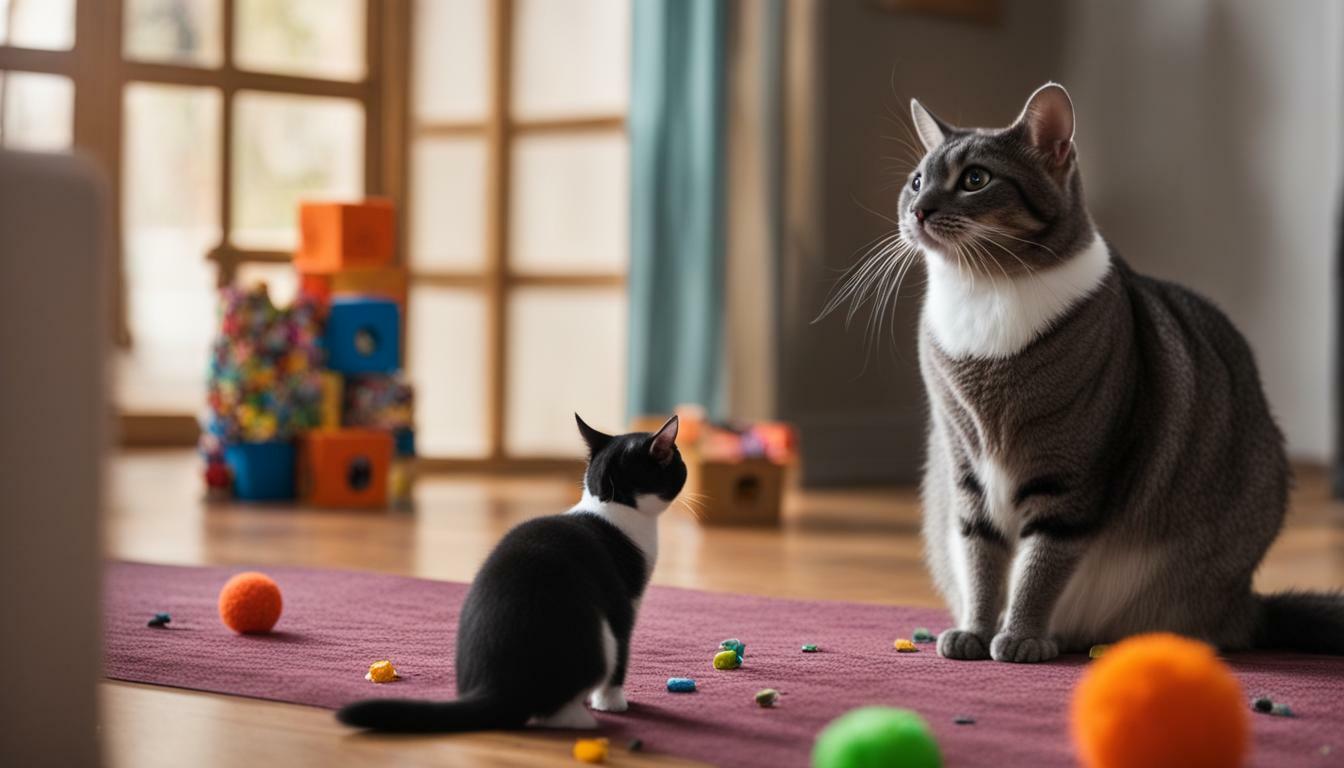If you’re wondering whether chinchillas can live peacefully with cats, it’s important to understand the dynamics and precautions involved. Chinchillas are prey animals, while cats are natural predators, so it’s essential to take extra care when introducing them to each other.
Chinchillas and cats can coexist, but it requires careful supervision and precautions to ensure their safety and well-being. Here are some key takeaways:
Key Takeaways:
- Chinchillas are prey animals, and cats are natural predators, so careful supervision is necessary.
- It is not recommended to let chinchillas and cats play together or house them in the same cage.
- Cats may attack chinchillas out of their natural instinct to hunt small animals.
- Disease transmission is a potential risk when they share the same living space.
- Slow and controlled introductions are crucial to minimize stress and potential conflicts.
Understanding the Nature of Chinchillas and Cats
Chinchillas, as prey animals, have certain instincts and behaviors that make their interaction with cats more challenging. In the wild, chinchillas are hunted by predators, and this natural instinct can be triggered when they are in the presence of a cat. It is important to understand that cats have a predatory nature, which can pose a threat to chinchillas.
When chinchillas feel stressed or threatened, they may exhibit signs of anxiety such as hiding, freezing, or attempting to escape. These behaviors are a result of their natural defense mechanism. Cats, on the other hand, may view chinchillas as prey and may try to chase, pounce, or attack them.
To ensure the safety and well-being of both pets, it is crucial to create an environment that minimizes stress and potential conflicts. This includes providing the chinchilla with a safe hiding spot where it can retreat from the cat’s presence. It is also important to give the chinchilla ample space to move around and exercise, away from the cat’s territory.
The Natural Predator-Prey Dynamic
It is essential to recognize that chinchillas and cats have different instincts and behaviors due to their roles in the natural predator-prey dynamic. While it is possible for them to coexist peacefully, it is important to keep in mind their natural tendencies and take precautions to ensure their safety.
| Chinchillas | Cats |
|---|---|
| Prey animals | Predators |
| Stress and anxiety in the presence of a predator | Natural instinct to hunt small animals |
| Need a safe hiding spot | May view chinchillas as prey |
| Require space to move and exercise | Territorial tendencies |
The Risks of Allowing Cats and Chinchillas to Play Together
Allowing cats and chinchillas to play together without proper precautions can pose significant risks to both pets. Chinchillas are prey animals by nature, so being in the presence of a cat, which is a natural predator, can cause them stress and fear. Cats may instinctively view chinchillas as potential prey and may attempt to hunt them, leading to potential injuries or even fatalities.
Moreover, there is a risk of disease transmission between cats and chinchillas. Cats can carry bacteria and parasites that could be harmful to chinchillas, such as toxoplasmosis or flea infestation. Close contact or exposure to contaminated environments can result in illness for chinchillas, compromising their overall health and well-being.
To mitigate these risks, it is crucial to take proper precautions when introducing cats and chinchillas. A gradual and controlled introduction is recommended, allowing both animals to become familiar with each other’s scent and presence. Keeping the cat and chinchilla in separate areas initially and gradually increasing supervised interactions can help minimize the potential for aggression or harm.
It is important to remember that while chinchillas and cats can coexist in the same household, their relationship may not develop into a friendship. Chinchillas thrive in a stress-free environment with plenty of space and a secure hiding spot away from the cat’s reach. Regular monitoring is essential to ensure the safety of both pets and to address any signs of discomfort or aggression that may arise.
| Risks of Allowing Cats and Chinchillas to Play Together |
|---|
| Chinchillas may feel stressed or threatened in the presence of cats, which are natural predators. |
| Cats may view chinchillas as prey and may attempt to hunt them, leading to potential injuries or fatalities. |
| There is a risk of disease transmission between cats and chinchillas, compromising their health. |
| Proper precautions, such as gradual introductions and providing separate spaces, are necessary to minimize risks. |
| Chinchillas and cats can coexist, but their relationship may not develop into a friendship. |
Slow and Controlled Introductions
When introducing a cat and a chinchilla, it is crucial to take things slow and ensure controlled interactions for their safety. Chinchillas are naturally prey animals, while cats have predatory instincts. To foster a peaceful coexistence, it is recommended to keep them in separate areas at first, gradually increasing supervised interactions over time.
Start by allowing the chinchilla to explore its new environment and become comfortable in its own space. Provide the chinchilla with a secure hiding spot, such as an enclosed hut or a high shelf, where it can retreat if it feels stressed or threatened by the cat’s presence.
Implementing a gradual introduction process:
- Begin by allowing the cat and chinchilla to interact through a closed door. This will enable them to become familiar with each other’s scents and sounds.
- Once they seem comfortable with this level of interaction, you can proceed to supervised face-to-face meetings. Make sure the cat is on a leash or held securely to prevent any sudden movements or aggressive behavior.
- Observe their interactions closely and be ready to intervene if necessary. Look for signs of stress or aggression from either animal, such as hissing, growling, or aggressive posturing.
- If all goes well during these controlled interactions, gradually increase their time together and eventually allow them to share the same living space under supervision.
Remember, each cat and chinchilla is unique, and the introduction process may vary depending on their individual personalities and behaviors. Patience and consistency are key to ensuring a safe and harmonious relationship between them. Seeking professional advice from a veterinarian or animal behaviorist can provide additional guidance and support throughout this process.
| Key Points | |
|---|---|
| Introduce the cat and chinchilla gradually | Provide a secure hiding spot for the chinchilla |
| Allow them to interact through a closed door initially | Supervise face-to-face meetings with the cat on a leash |
| Observe their interactions closely for signs of stress or aggression | Gradually increase their time together under supervision |
| Seek professional advice if needed |
Giving Your Chinchilla Space and a Safe Hiding Spot
To help your chinchilla feel safe and secure around a cat, it’s essential to provide it with enough space and a designated hiding spot. Chinchillas are naturally skittish animals, and the presence of a predator like a cat can cause them stress and anxiety. By creating a chinchilla-friendly environment, you can help alleviate their fear and ensure their well-being.
Firstly, make sure your chinchilla has a spacious enclosure that allows it to move around freely. Chinchillas need room to exercise and explore, so a large cage with multiple levels and plenty of hiding spots is ideal. Avoid placing the cage in an area where the cat can easily access it, as this may cause unnecessary stress for your chinchilla.
In addition to providing ample space, it’s crucial to offer a safe hiding spot where your chinchilla can retreat whenever it feels threatened. This can be a cozy nest box, a wooden hideout, or a specially designed chinchilla house. Place the hiding spot in a quiet corner of the cage, away from any potential disturbances. This will give your chinchilla a place to escape to when it needs a break from the cat’s presence.
| Chinchilla Space and Hiding Spot Tips: |
|---|
| 1. Provide a large, multi-level cage for your chinchilla to move and play in. |
| 2. Place the cage in an area where the cat cannot easily reach it to avoid unnecessary stress for your chinchilla. |
| 3. Offer a safe hiding spot, such as a cozy nest box or wooden hideout, where your chinchilla can retreat. |
| 4. Position the hiding spot in a quiet corner of the cage, away from potential disturbances. |
| 5. Regularly observe your chinchilla’s behavior to ensure it feels comfortable and secure in its environment. |
By following these guidelines, you can create a comfortable and safe living space for both your chinchilla and your cat. Remember, the key to successful coexistence is to prioritize your chinchilla’s well-being and provide it with the necessary space and hiding spot to feel secure.
Monitoring for Safety
Regular monitoring is crucial to ensure the safety and well-being of both your chinchilla and cat when they coexist in the same household. As natural predator and prey, cats and chinchillas have different instincts and behaviors that can potentially pose risks. By keeping a watchful eye and taking necessary precautions, you can create a safe environment for both pets.
During their initial introductions, it is important to keep the cat and chinchilla in separate areas, allowing them to become familiar with each other’s scents without direct interaction. Gradually, you can increase their supervised interactions while closely observing their behaviors. Look out for signs of stress, fear, or aggression, and intervene if necessary to prevent any potential harm.
Monitoring for safety also involves providing your chinchilla with space and a secure hiding spot. This allows them to retreat and feel safe when they need a break from the cat’s presence. Ensure that their hideout is inaccessible to the cat, providing a peaceful sanctuary for your chinchilla.
| Monitoring Tips for Chinchilla and Cat Coexistence |
|---|
| Keep the chinchilla’s cage in a secure location, away from the cat’s reach. |
| Observe their interactions closely to prevent any aggressive behavior or chasing. |
| Separate them if you notice signs of stress, fear, or aggression from either pet. |
| Provide your chinchilla with ample space and a safe hiding spot where the cat cannot access. |
| Regularly clean and disinfect the chinchilla’s cage to minimize the risk of disease transmission. |
Remember that coexistence does not always mean they will become best friends. It is essential to respect their individual needs and boundaries. Seek professional advice from a veterinarian or animal behaviorist if you encounter any difficulties or have concerns about the relationship between your chinchilla and cat.
Coexistence vs. Friendship
While it is possible for chinchillas and cats to live together, it’s important to understand that their relationship may be one of coexistence rather than close friendship. Chinchillas are prey animals and cats are natural predators, so their instincts may cause tension and potential danger. It is not recommended to allow them to play together or share the same living space without careful supervision and precautions.
When introducing a cat and a chinchilla, it’s crucial to take it slow and control the interactions. Start by keeping them in separate areas and gradually increase their supervised interactions. This will allow them to get used to each other’s presence without feeling threatened. Providing the chinchilla with enough space and a safe hiding spot away from the cat is also essential. This will give the chinchilla a sense of security and a place to retreat when needed.
Regular monitoring is key to ensuring the safety of both pets. Observe their interactions and behavior closely, and be prepared to intervene if necessary. Remember that cats have a natural instinct to hunt small animals, so it’s important to be cautious and vigilant. While a chinchilla and cat can coexist peacefully, it’s important to manage your expectations. They may not become best friends or engage in friendly play. Instead, focus on creating an environment where they can both feel safe and comfortable in each other’s presence.
| Key Points: |
|---|
| Chinchillas are prey animals and cats are natural predators, which can cause tension and potential danger. |
| Take slow and controlled introductions, keeping the cat and chinchilla in separate areas initially. |
| Provide the chinchilla with sufficient space and a secure hiding spot away from the cat. |
| Regular monitoring is essential to ensure the safety of both pets. |
| Manage expectations and understand that their relationship may be one of coexistence rather than close friendship. |
Precautions to Take When Introducing Cats and Chinchillas
Introducing cats and chinchillas requires careful planning and precautionary measures to ensure a smooth and safe transition for both pets. Here are some essential precautions to keep in mind:
- Separate living spaces: When bringing a cat and a chinchilla into the same household, it is crucial to provide them with separate living spaces initially. This allows them to acclimate to their new surroundings without direct interaction. Gradually introduce them to each other under controlled circumstances.
- Supervised interactions: When it’s time to introduce the cat and chinchilla, make sure it is done under close supervision. Never leave them alone together unsupervised, especially in the beginning. Monitor their behavior and intervene if any signs of aggression or stress are displayed.
- Slow and gradual introductions: Patience is key when introducing cats and chinchillas. Start by allowing them to sniff each other’s scents from opposite sides of a closed door. Then, gradually open the door a crack so they can see each other, while still maintaining a safe distance. Increase their interaction time gradually, always prioritizing their comfort and safety.
- Provide escape routes and hiding spots: Chinchillas are naturally skittish animals, so it’s important to provide them with plenty of hiding spots and escape routes when they are sharing a living space with a cat. This can include tall platforms, tunnels, or hideouts where the chinchilla can retreat to if it feels threatened or overwhelmed.
Remember, coexistence between cats and chinchillas is possible, but it doesn’t guarantee a close friendship between the two. Cats have an instinctual prey drive, so it’s important to manage their interactions and maintain a safe environment for both pets. Seek professional advice from a veterinarian or animal behaviorist for guidance specific to your cat and chinchilla’s needs.
Introducing Cats and Chinchillas: A Precautionary Checklist
| Precautions | Explanation |
|---|---|
| Separate living spaces | Provide each pet with its own designated area to avoid immediate physical contact. |
| Supervised interactions | Keep a close eye on the cat and chinchilla during their initial interactions to ensure their safety. |
| Slow and gradual introductions | Allow the pets to become familiar with each other’s presence over time, gradually increasing their face-to-face interactions. |
| Escape routes and hiding spots | Provide the chinchilla with safe spaces to retreat to in case it feels threatened or overwhelmed by the cat’s presence. |
By following these precautions and taking the necessary steps to ensure a controlled and safe introduction, you can increase the chances of a successful coexistence between your cat and chinchilla. Remember, their well-being should always be the top priority.
Creating a Chinchilla-Friendly Environment
Creating a chinchilla-friendly environment can help your furry friend feel more at ease and secure in the presence of a cat. Chinchillas are highly sensitive animals, and it’s important to provide them with a calm and safe space that meets their specific needs.
Start by setting up a spacious cage for your chinchilla, ensuring that it is placed in a quiet area away from any potential disturbances. Line the cage with a soft bedding material, such as aspen shavings or paper-based bedding, which provides comfort and absorbs moisture. Chinchillas also love to chew, so be sure to include plenty of safe chew toys and wooden blocks to keep them entertained.
In addition to the cage, create a designated play area for your chinchilla to explore and exercise outside of its enclosure. This area should be escape-proof and free from any potential hazards, such as electrical cords or toxic plants. Consider providing climbing structures and tunnels for your chinchilla to enjoy, as they love to climb and explore their surroundings.
Chinchilla-Friendly Diet and Hydration
Proper nutrition is essential for your chinchilla’s overall well-being. Provide a diet that consists primarily of fresh hay, along with small amounts of specially formulated chinchilla pellets and fresh vegetables. Avoid feeding your chinchilla any foods that are high in sugar, fat, or artificial additives, as these can be harmful to their health.
| Food | Amount |
|---|---|
| Timothy Hay | Free-choice, always available |
| Chinchilla Pellets | 1-2 tablespoons daily |
| Fresh Vegetables | 1-2 tablespoons daily |
Water is also crucial for your chinchilla’s health. Provide fresh, clean water in a sipper bottle that is securely attached to the cage. Check the water bottle regularly to ensure it is functioning properly and refill it daily.
Soothing Environment and Handling
Chinchillas are easily stressed, so it’s important to create a soothing environment that minimizes noise and sudden movements. Avoid placing the cage near loud appliances or in high-traffic areas of your home. Additionally, handle your chinchilla gently and with care to build trust and minimize stress. Avoid sudden movements or loud noises when interacting with your pet.
By creating a chinchilla-friendly environment that includes a spacious cage, designated play areas, a nutritious diet, and a soothing atmosphere, you can help your chinchilla feel more comfortable and secure in the presence of a cat. Remember to always supervise their interactions, provide regular monitoring, and consult with a professional if you have any concerns or questions about their coexistence.
Training Your Cat and Chinchilla
Training your cat and chinchilla can help establish boundaries and foster a more harmonious coexistence between the two pets. By teaching them to understand and respect each other’s needs, you can create a safer and more comfortable environment for both animals.
When it comes to training your cat, start by introducing them to the chinchilla’s scent. Allow the cat to sniff an object that has the chinchilla’s scent on it, such as a piece of bedding. This helps familiarize the cat with the chinchilla’s presence without direct contact.
Next, gradually introduce supervised interactions between the cat and chinchilla. Start with short sessions where both pets are in the same room but separated by a safe barrier, such as a baby gate. Over time, you can allow them to be in the same space without any barriers, always keeping a close eye on their behavior.
| Tips for Training Your Cat and Chinchilla: |
|---|
| 1. Use positive reinforcement: Reward both the cat and chinchilla with treats or praise when they exhibit calm and non-aggressive behavior towards each other. |
| 2. Provide separate spaces: Ensure that each pet has their own designated area where they can retreat to when they need some alone time. |
| 3. Use deterrents: If the cat displays predatory behavior towards the chinchilla, consider using deterrents like motion-activated sprays or noise devices to discourage any hunting instincts. |
Remember that training takes time and patience. Be consistent in your approach and always prioritize the safety and well-being of both pets. Seeking professional advice from a veterinarian or animal behaviorist can also provide valuable guidance in managing the relationship between your cat and chinchilla.
Seeking Professional Advice
If you’re unsure about how to proceed with introducing and managing the dynamic between your cat and chinchilla, seeking professional advice can provide valuable insights. Veterinarians and animal behaviorists are experts in understanding animal behavior and can offer guidance tailored to your specific situation. They can assess the personalities and behaviors of both your cat and chinchilla, and recommend strategies for a successful coexistence.
Professional advice can help you navigate the challenges that may arise during the introduction process. They can provide step-by-step instructions on how to introduce the two animals safely, gradually increasing their supervised interactions over time. They may also suggest training techniques to help your cat and chinchilla understand and respect each other’s boundaries.
Additionally, professionals can offer guidance on creating a chinchilla-friendly environment that promotes their comfort and reduces stress. They may recommend adjustments to your home’s layout, such as providing ample space for the chinchilla to retreat and setting up a safe hiding spot away from the cat’s reach.
Benefits of Professional Advice
- Expert guidance tailored to your specific situation
- Step-by-step instructions for safe introductions
- Training techniques to establish boundaries
- Tips on creating a chinchilla-friendly environment
Remember, professional advice is crucial to ensure the safety and well-being of both your cat and chinchilla. With their expertise, you can minimize the risks and maximize the chances of a harmonious coexistence between these two animals.
| Section | Content |
|---|---|
| Section 11 | Seeking Professional Advice |
Conclusion
In conclusion, while chinchillas and cats can coexist, it requires careful introductions, monitoring, and providing a safe environment for both pets to ensure their well-being and safety. Chinchillas, being prey animals, may feel stressed and threatened in the presence of cats, which are natural predators. It is not recommended to let them play together or share the same cage due to the risk of attacks and disease transmission.
However, with slow and controlled introductions, it is possible for a chinchilla and cat to live peacefully in the same household. Giving the chinchilla enough space and a secure hiding spot where it can retreat from the cat’s presence is crucial. Regular monitoring is necessary to ensure the safety of both pets and to address any potential conflicts.
It is important to note that while chinchillas and cats can coexist, they may not necessarily become best friends. Each pet has its own instincts and behaviors, and it is crucial to respect their individual needs. Seeking professional advice, such as consulting a veterinarian or animal behaviorist, can provide further guidance on managing the relationship between cats and chinchillas.
Overall, by taking precautions, creating a chinchilla-friendly environment, and training both pets to understand and respect each other’s boundaries, it is possible to create a harmonious living arrangement for chinchillas and cats. Remember to prioritize the safety and well-being of your pets above all else.
FAQ
Can chinchillas and cats get along?
Yes, but it requires careful supervision and precautions.
Are chinchillas prey animals?
Yes, chinchillas are prey animals and may feel stressed or threatened in the presence of a natural predator like a cat.
Is it recommended to let cats and chinchillas play together?
No, it is not recommended to let them play together or house them in the same cage due to the risk of attacks and disease transmission.
How can cats and chinchillas coexist peacefully?
With slow and controlled introductions, providing the chinchilla with space and a safe hiding spot away from the cat, and regular monitoring.
Will cats and chinchillas become best friends?
While they can live together, it’s important to remember that they may not necessarily become best friends.




